Posts Tagged ‘Syria’
Refugees: The Great Walk Now or Never
The black rubber dinghy had just landed on Mytileni’s rocky beach on the Isle of Lesvos, Greece. The 41 people crammed precariously on the raft quickly dropped their orange life jackets and looked around to make sure their friends and relatives had also made it to land.
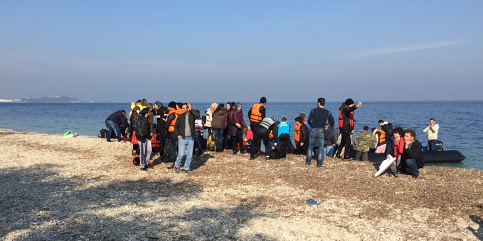
A father knelt before his curly headed son, around 3 years old, took off his life jacket, checked his clothing—damp, but not too wet—and tried to explain where they were. The boy smiled, looked about and then spent his time trying to get his heel back into one of his wet sneakers. I was able to help him as his father looked for his wife, who’d made it to land further down the beach. The family had left Aleppo a week ago, waited three days on the Turkish coast near Izmir for transport and now, finally had safely reached the shores of Europe.
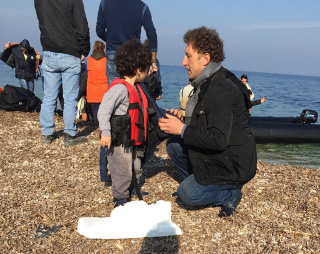
From here they would continue their long journey to a new life, which they hoped would be in Germany. Before them lay at least half a dozen train and bus rides and walks with their two backpacks containing all their belongings. Also ahead were multiple registration centers in each country they would pass through.
Along with the 760,000 people who have come through Greece since April, they were embarking on “The Great Walk,” or some call the trek “The Great Wait.” With winter coming and borders closing, it is a “now-or-never” journey as Europe absorbs the largest migration since World War II. Almost half—45%—come through Lesvos, 58% men, 16% women, 26% children, according to statistics from the United Nations High Commission on Refugees (UNHCR).
As Syrians, they are lucky, if having to flee one’s home destroyed in war can be considered luck. Most Syrian refugees—96-98%—will eventually find new residencies. Syrians comprise 45% of this great exodus. Another third are Afghan, a tenth are Iraqi. The rest are Eritrean, Central African Republic, Iranian, Somalians, Moroccan, Algerians and others, according to figures from UNHCR. The latter four nationalities have slim chances to resettle in Europe.
In the past month access for “direct arrivals” has closed. Only refugees from Syria, Iraq and Afghanistan are allowed the onward journey into Europe. These nationalities comprise 85% of those on the move. The rest are turned back. The European Union has also agreed to accept 160,000 in a formal resettlement process, which takes one to two months and requires refugees to accept whatever country they are assigned. Again, only certain nationalities are included in this relocation process—Syrians, Iraqis, Eritreans, those from the Central African Republic and perhaps soon Afghans, according to Alessandra Morelli, UNHCR Senior Operations Coordinator in Greece.
“History is passing in front of our eyes,” Ms. Morelli says at the UNHCR office in Athens. “I feel responsible that we build a Europe that is open and not one of walls.”
In the Lesvos registration site Kara Tepe I met with a group of 21 family and friends who’d arrived earlier in the day. They had come through Lebanon from their village and were part of a small Shia sect of the Alawites. The Assad forces had insisted the men must join the Army at the same time ISIS had come to the village and kidnapped three girls and killed many people and threatened that if the men didn’t join them and convert, they would be killed.
They fled the village, leaving behind a 65-year old father, a lawyer who’d been imprisoned and tortured and didn’t want to leave. Another woman through tears said her 19-year old son was still in Turkey trying to raise money to cross. She would stay on Lesvos until he joined her. Among their group were infants and toddlers, who were now running in and out of the small Ikea houses assigned to the families until they moved on later in the day or the next day.

“I fled not as a deserter, but because I didn’t want to fight,” said one of the fathers. “It was impossible to live in Syria any longer with our family. We needed $12/day to live and could only make $2. I was working in a restaurant; my wife studied French in university and couldn’t find a job. For the last three years there have been no jobs. There was constant shelling. Our children were afraid. There was no future for them, and we are watched on all sides. Planes are constantly flying over; the children aren’t sleeping; shooting is everywhere. When it’s dark, no one goes out.
“But despite all the difficulties we still face, we feel safe now,” he added. “We’ve received good treatment here, enough to feel like human beings again. I want my children to be raised in Europe out of all the bad complexities in my part of the world.”
Harsh stories abound for each refugee, but there are also stories of hope and of an outpouring of good will along the way. Volunteers from Greece and all over Europe have come to assist. There are Doctors Without Borders treating the sick, Clowns Without Borders entertaining the children; there are Families Like Ours from Portugal providing tons of clothes, Green Helmets from Germany putting in wooden floors in the tents, Samaritans are winterizing the shelters with tarps. There is a local Greek mother who donated a stroller and wrote a letter to the mother who would receive it. There are Spanish Life Guards who wait on the beaches in wet suits, ready to go out into the ocean to help those trying to get to shore.
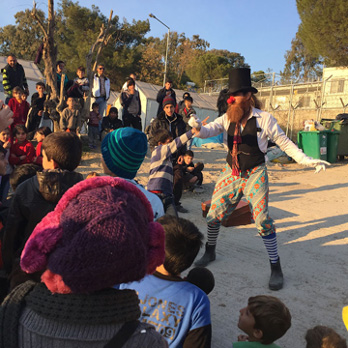
There are local and international nongovernmental organizations—Save the Children, Action Aid, Habitat for Humanity, International Rescue Committee, Red Cross, etc., all taking up specific roles in this migration. There are agencies of the European Union, providing security and registration.
Since early fall the United Nations High Commission on Refugees has been on the ground helping coordinate all these processes. The priorities for the refugees are employment and education for their children.
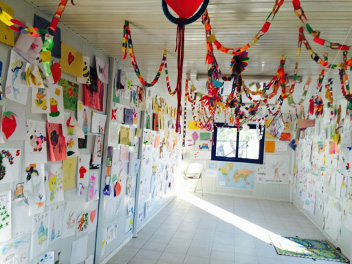

Their journeys, with variations, look like this: They arrive from Syria into one of the bordering countries—Iraq, Jordon, Lebanon or Turkey. There they likely find a smuggler, pay the fee, wait on the border for their turn, sometimes a wait of several days. From Turkey, they climb on a raft, often at night so they are less likely to be seen, and they take the 4-6 mile trip of 2-4 hours, depending on conditions. Shipwrecks and drowning are real dangers and have taken the lives of hundreds, six Afghans just in the time I was there.
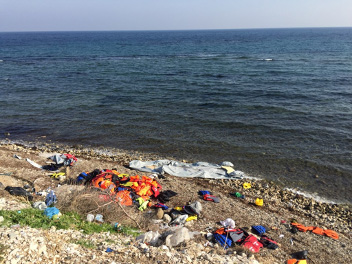
On the beach they are met by volunteers and usually by representatives of the EU or UNHCR and the Greek municipality, who take them to a first staging area, where they are given food, water, the opportunity to shower, charge their phones, and change into dry clothes if needed. They are then put on a bus and taken to the registration centers, where their papers are checked; they are finger printed; their nationalities are sorted out; they are given official registration documents and advised on possible next steps. This process can take 2-8 hours. They have the option of staying the night in a tent or small Ikea house for families.

From the registration center they continue to Athens on a ferry. This they must pay for. Their registration and documents are again checked, and they board buses to Idomeni in Northern Greece near the Macedonian border, where, if they are Syrian, Iraqi or Afghan, they are allowed to cross. They walk from the border to a registration site, enter a large tent with wooden benches and wait to be called to register again, this time for Macedonian papers. After registration, they are given food and water, clothes if they need. At all the centers there are safe places and play spaces for women and children, run by Save the Children and other organizations. Over the loud speaker the announcement of all the services available are repeated in English and Arabic, including: “You don’t need to pay for anything.” Everything at the site is free. They wait in tents or in small Ikea houses or outside if the sun is shining for the train to arrive. The train was late the day we were there, and it is not free. It will eventually take them to Serbia, where they must walk to the registration center and again register for new documents. From there they will get trains or buses to their next destinations with walking in between, making their journey northward to Croatia, Slovenia, Hungary, Austria and for many on to Germany or Sweden or other countries.

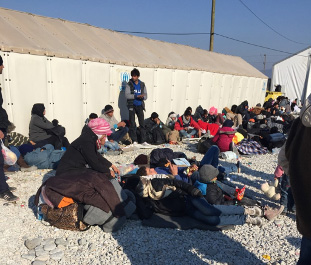
War is at their back. Their future is focused on their children. Their destinations are partly places of imagination, where they imagine jobs and schools and safety. But the triage is intensifying. Winter is coming. The European Union is paying Turkey three billion Euros to secure its borders and service the three million refugees already in Turkey so that they stay. Quotas are filling rapidly in countries like Germany and Sweden, where refugees perceive opportunities. Through facebook and through families who have gone before them, and from the media, Germany and Sweden and Holland and a few other countries have become their mecca, and countries like Portugal, which is open to refugees, have so far received few.
“They are families like us. We want to help,” said Barbara Guevana at the Macedonian border camp. She is one of the founders of Familias Como as Nossas—Families Like Us—a group of women who didn’t know each other but connected through facebook to assist Syrians with housing, education and transportation to Portugal, which has allotted 4500 spaces for refugees. Seventeen women drove three days to Croatia to meet Syrian families, taking with them clothes and food and assuring them Portugal was waiting to welcome them.
“But people don’t know about Portugal,” said Ms. Guevana. “In Arabic the name means ‘Orange,’ and they question why they should go to ‘Orange.’ We assure them we want them to come. The Portuguese government is willing to fly them to Portugal if they get to Austria.”
This migration is changing the face of Europe and challenging the future of the European Union. “We need to manage borders, not close them,” insists Philippe Leclerc, the new UNHCR representative, who has just arrived to head the Greek operation.
While Germans, French and Austrians were at first welcoming, Eastern European nations like Poland, Hungary, Slovakia have been more resistant. And everyone agrees that the November terrorist attacks in Paris have changed attitudes.
“We need to realize these people are fleeing the terrorists; they are not the terrorists,” said Maureen White, board member of the International Rescue Committee and director of Johns Hopkins School of Advanced International Studies Center on Migration and a fellow traveler on this trip.
As the sun sets, we drive from Macedonia through the official checkpoint, showing our passports at each border as we return to Thessalonica. When we cross into Greece, we find our car behind a caravan of busses filled with refugees and migrants who are being returned to Athens. Today was a major police action that cleared the area called “the Green Field” where those not allowed to cross had started camping and piling up. These are not Syrians, Iraqis or Afghans, but all the other nationalities who hoped to pass into Europe. Nineteen hundred people in 49 buses will be put up for the night in the old Olympic facilities in Athens and in the morning told their options, including applying for asylum in Greece, an unlikely outcome, applying for resettlement, an option at the moment only for Syrian, Iraqi, Eritrean and Central Africans or returning to their countries of origin.
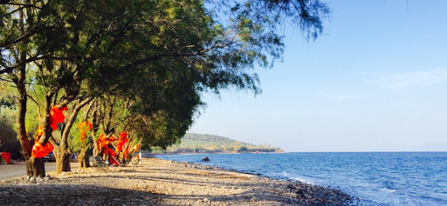
Welcome Home? Syrian Refugees Building On Top of History
I recently returned from visiting Syrian refugees in northern Iraq and Jordan on a field mission with Refugees International. As I handed over my passport and custom’s form to the U.S. officer, he said: “Welcome home!”
That greeting always touches me but more than ever after this trip spending time with refugees who have no idea when and if they might be able to go home, who no longer know where their home is. Hundreds of thousands are living in tents and caravans and many in even more problematic structures in fields and behind houses across the border from Syria. Men, women and children–often on foot or in buses and taxis–have fled into Iraq, Jordan, Lebanon, Turkey and countries further away.
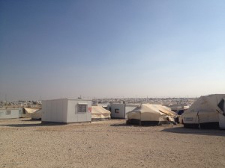
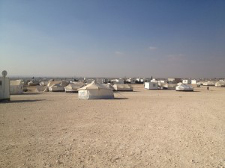
The displacement from the three-year old civil war in Syria has caused the worst refugee crisis since Rwanda, according to officials at the United Nations High Commission on Refugees (UNHCR). They estimate that at least two million people have fled across Syria’s borders and millions more are internally displaced. Adding to the challenge of assisting these people are the growing restrictions on crossing from Syria into Iraq and Jordan, restrictions which some complain are tantamount to closing the borders.
In Jordan, a country of six million people, the UNHCR believes that there are nearing 600,000 refugees, and some others estimate the figure to be over a million. In both Iraq and Jordan, only a third of the refugees are in camps; the rest are dispersed throughout cities and towns, often unregistered and without services.
“We walked three days in the dark, at night, afraid, carrying our two children,” said one young man, who travelled with his wife and three-year old son and one-year old daughter, trying to avoid the fighting. They finally got a ride and arrived at Za’atari refugee camp in the desert of northern Jordan. The Za’atari camp, originally built for 10,000 people, currently houses over 80,000 and at times has held as many as 150,000. The camp is now the fourth largest “city” in Jordan.
Though conditions have improved considerably, according to those who have visited the camp in the past, the landscape at Za’atari is stark—five square miles of barren rocky desert with tents and caravans laid out as far as the eye can see. There is not a single tree or bush or plant anywhere, nothing to break the view except coiled barbed wire around certain parts of the compounds. Running through the middle of the acres of desert is a dusty path with stalls on either side where residents sell vegetables, clothes, shoes and other wares. The residents have dubbed it the Champs Élysées. A new camp nearby has been set up and will soon take the overflow from Za’atari.
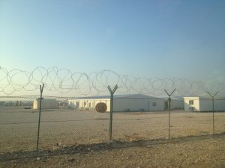
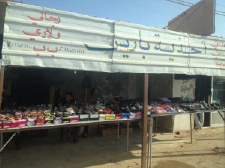
The conflict in Syria is only eight miles away. According to one humanitarian aid worker, you can sometimes hear the explosions. The proximity to the border and the conflict adds to the insecurity in the camp.
“Za’atari is the tip of the iceberg of the Syrian crisis,” said Kilian Kleinschmidt, the camp manager.
Za’atari is said to be the second largest refugee camp in the world. Since Kleinschmidt arrived in March, the violence in the camp has decreased, but there is still considerable resistance to authority, he says. “The challenge is for the people to respect some authority so when the refugees return, they can rebuild and govern Syria. If people return with the state of mind now, it is going to be difficult.”
In the past months the camp has been divided into 12 districts. The UNHCR camp manager is planning for everyone to be registered with an address so each refugee can be located. Another goal is to replace tents with metal caravans, which offer more protection from the elements.
“People want to be able to stand upright in their homes and be able to lock their door at night,” Kleinschmidt said. But the caravans promised by international donors are no longer arriving in the numbers needed.
The camp is preparing for winter. Ninety thousand thermal blankets had just arrived, and winterization packages were being assembled which would also include plastic sheeting, kerosene and heaters. A few days before 20,000 ration cards had been deactivated in an attempt to get an accurate registration roster. A large protest had broken out, including among those whose ration cards no longer worked.
Education for the children is a significant challenge in Za’atari and at other refugee camps as well as among those living out in the Jordanian communities. In Za’atari an estimated 13,000 children attend school out of 18,000 enrolled and an estimated 55,000 youth in total. Outside the camps parents often face fees and expenses for schools. One parent living in a community outside the camp said he wanted to send his children to school, but he didn’t have the funds, and he was not allowed to work to earn the money. In Syria he had been a school principal.
As the year ends, the region is facing increasing needs and another shortfall of funds, according to Daryl Grisgraber, senior advocate for Refugees International. (Running Za’atari is said to cost roughly $500,000/day.) But there is also some progress with more countries willing to take in Syrian refugees on humanitarian grounds.
Despite the harsh conditions in Za’atari, there are signs of hope. Myriad small enterprises—30 restaurants, a supermarket, even a new coffee shop—have sprung up. There are many more births (10 per day) than deaths (5 per week).
The situation in northern Iraq appears less tense than in Jordan, perhaps because both the refugees and the residents are Kurdish.

At a local community-based organization in Sulaymaniyah one worker noted, “There is a bond between us. The Syrians Kurds took us in at a time we needed help. Now we can help them.”
The staging areas for urban refugees who come to Sulaymaniyah for assistance is a former military barracks where Saddam Hussein’s army tortured Kurdish citizens in an underground chamber. The conversion of the barracks and torture chambers into a community center was financed by a grant from the U.S. government which is reported to have contributed $1 billion to the Syrian refugee crisis. Now refugees gather in the former barracks to get assistance with housing, food and education. In Northern Iraq the refugees are given six-month residence permits that are renewable, and a new program has just commenced offering 70- four-year university scholarships to refugees who have competed and qualified for the slots.
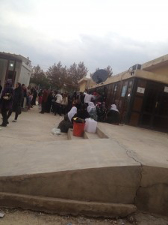
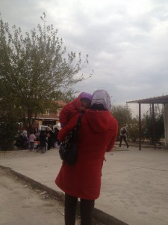
“Our home was bombed. Though we lived just four miles from the Turkish border, we came here because for us the language is better and the people know us. In the war of ’91 the Syrian people helped the people here,” said one father of two. He has pitched a tent in a field where he helps on the farm, though when the farming season is over, he doesn’t know where he and his family will live.
Worlds Apart Review
Former US Ambassador to Austria Swanee Hunt writes hauntingly of the “grand intentions and missed opportunities” that prevented us from protecting Bosnians.
By Joanne Leedom-Ackerman / March 13, 2012
(This review originally appeared in the Christian Science Monitor.)
The city is surrounded. Shelling rains down on the population. Sniper fire, bombs, mortars erupt from all directions. There are no safe havens for civilians; dozens are killed each day. The international community meets, protests, debates what should be done. Powerful players like Russia obstruct action. Sanctions are tightened, but it is citizens who suffer most. Outside nations are willing to offer humanitarian aid, but are conflicted about arming the opposition. The UN organizes peacekeeping forces, but the mandate and rules of engagement are unclear. The siege and the deaths continue … for years.
This description could be from today’s headlines in Syria, but instead it is the siege of Sarajevo in Bosnia 20 years ago. The paralysis of the international community to intervene and prevent the killings of citizens is still haunting.
In Worlds Apart, former Austrian Ambassador Swanee Hunt chronicles her years (1993-1997) on the inside and the outside of the corridors of war in Bosnia. As the US Ambassador located in Vienna, she sat at embassy dinners, met with European and US government officials, engaged in countless discussions of what should be done. She also used her position, both geographic and political, to visit with the citizens of Bosnia dozens of times in the country and to bring citizens outside the country to meet with each other.
“Worlds Apart” – part memoir, part foreign policy text – is narrated in an informal, first person voice, with 80 vignettes that present the story from the inside point of view of citizens, humanitarian aid workers, human rights workers, and journalists and from the outside view of policymakers, diplomats, military leaders, and international politicians, most of whom had limited interaction with the citizens living through the ordeal.
“This is a book about Bosnia – and beyond. Its lessons reach to Egypt, Iraq, Korea, Congo … any place we as an ‘international community’ try to stabilize a chaotic world,” Ambassador Hunt writes in the Prologue. “It is a story of grand intentions and missed opportunities, heroes and clowns, and a well-meaning foreign policy establishment deaf to the voices of everyday people.”
Hunt draws multiple lessons throughout the book, but the overall lesson is that solutions must include both inside and outside actors. Central to the inside group are women who often are willing to set aside the most wrenching experiences in order to restore life for their families and communities. Yet few women are invited to the peace tables, and few are consulted in the processes of peace.
In April 1996, Hunt offered President Bill Clinton two pieces of advice: “We must come up with a more solid approach to the war criminals living within a few miles of the troops…. We need a strongly targeted effort now to strengthen the role of women in Bosnia.”
Among the compelling stories in the book is the author’s harrowing journey from Sarajevo to Lyons, France, where she briefed President Clinton before he addressed the international press at the G-7 meeting. In that rushed encounter, she focused on the Bosnian Women’s Initiative. “These women are working together – across political fault lines,” she told him. “They’re the best story you’ve got.”
“Worlds Apart” is a moving political and personal story, unique in its telling and in its voice. It is rich with narrative details and also with analysis that makes it a valuable text in the literature of the Balkan War. There are many perspectives on that war, and there are those who may take issue with some of Hunt’s criticisms, but she also criticizes herself.
At one point, she visits with theorist and psychiatrist Viktor Frankl, a mentor and a Nazi Holocaust survivor. She asks if she should resign in protest over the inaction. He answers, “Madame Ambassador, sometimes the right thing to do is only 55 percent right and is 45 percent wrong. It’s hard enough for an individual to act in those situations. For a giant like the US government, it’s paralyzing.”
“Worlds Apart” reminds the reader how difficult and yet imperative is individual and collective action in the face of moral collapse. The most effective action links head and heart – “policies determined in logic-driven consultations and the pathos bred in brutalizing situations…. Only then will we have the intellectual and emotional wherewithal to bring together the two worlds apart, making them one, more just and secure.”
It took over a decade for Swanee Hunt to distill and to write the experiences from Bosnia. That history and its lessons remain eerily relevant today.